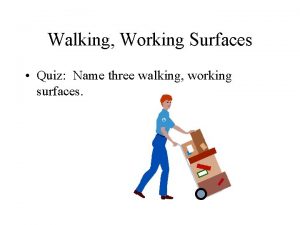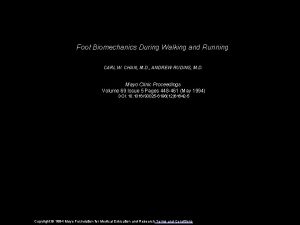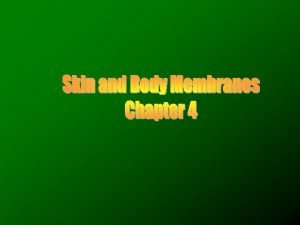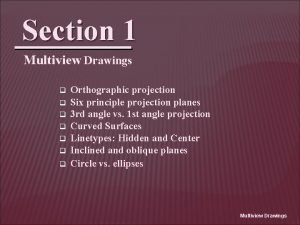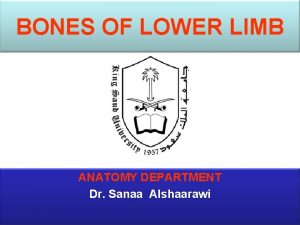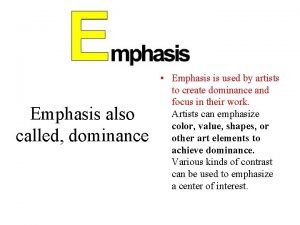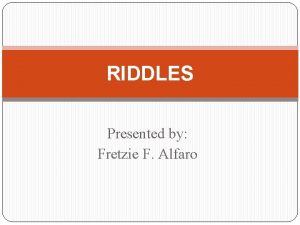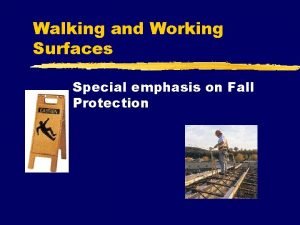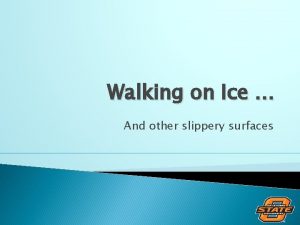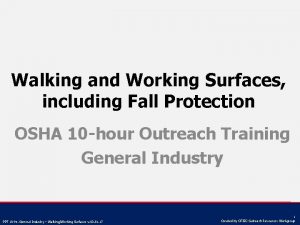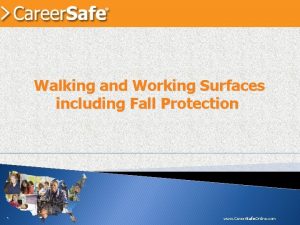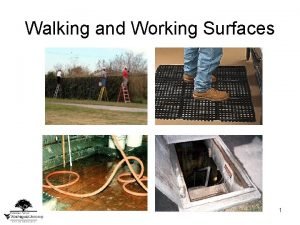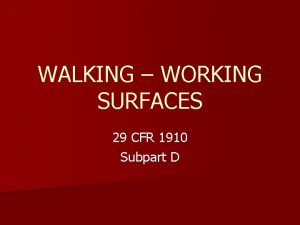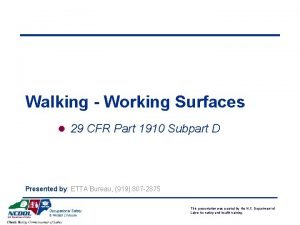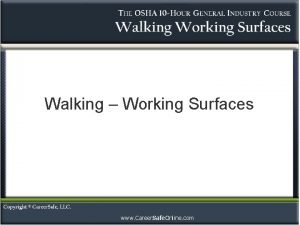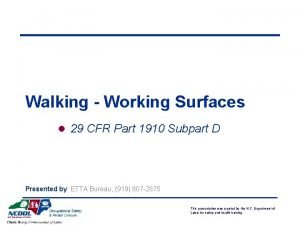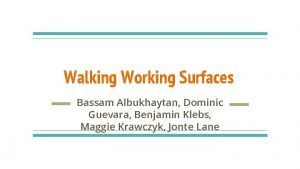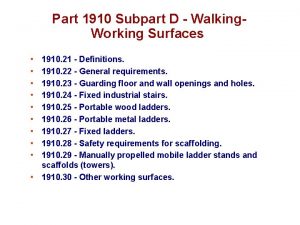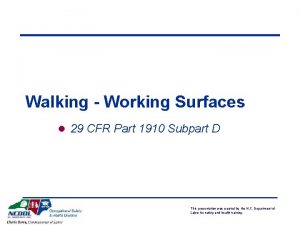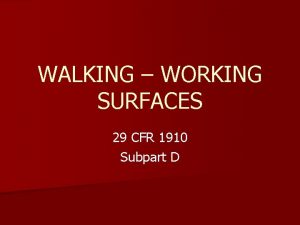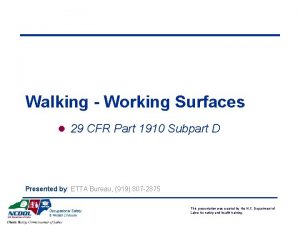Walking and Working Surfaces Special emphasis on Fall


































- Slides: 34

Walking and Working Surfaces Special emphasis on Fall Protection

The Regulations z 1910. 21 - Definitions. z 1910. 22 - General requirements. z 1910. 23 - Guarding floor and wall openings and holes. z 1910. 24 - Fixed industrial stairs. z 1910. 25 - Portable wood ladders. z 1910. 26 - Portable metal ladders. z 1910. 27 - Fixed ladders. z 1910. 28 - Safety requirements for scaffolding. z 1910. 29 - Manually propelled mobile ladder stands and scaffolds (towers). z 1910. 30 - Other working surfaces. z 1910 Subpart D Authority for 1910 Subpart D

General Requirements Housekeeping z All places of employment, passageways, storerooms, and service rooms shall be kept clean and orderly and in a sanitary condition. z The floor of every workroom shall be maintained in a clean and, so far as possible, a dry condition. Where wet processes are used, drainage shall be maintained and gratings, mats, or raised platforms shall be provided. z Every floor, working place and passageway shall be kept free from protruding nails, splinters, holes, or loose boards.

General Requirements Aisles & Passageways z Aisles and passageways shall be kept clear and in good repair with no obstruction across or in aisles that could create a hazard. z Permanent aisles and passageways shall be appropriately marked. z Where mechanical handling equipment is used, aisles shall be sufficiently wide. Improper aisle widths coupled with poor housekeeping and vehicle traffic can cause injury to employees, damage the equipment and material, and can limit egress in emergencies.

General Requirements Covers & Guardrails z. Covers and/or guardrails shall be provided to protect personnel from the hazards of open pits, tanks, vats, ditches, and the like. z. Skylights shall also be protected to prevent accidental falling through.

General Requirements Floor Loading Protection z. Load rating limits shall be marked on plates and conspicuously posted. z. It shall be unlawful to place, or cause, or permit to be placed, on any floor or roof of a building or other structure, a load greater than that for which such floor or roof is approved.

Determining an Opening z Floor hole. An opening less than 12 inches but more than 1 inch in its least dimension, in any floor, platform, pavement or yard, through which materials but not persons may fall. z Floor opening. An opening 12 inches or more in any floor, platform, pavement, or yard, through which persons may fall. z Platform. A working space for persons, elevated above the surrounding floor or ground. z Wall hole. An opening less than 30 inches but more than 1 inch high, of unrestricted width, in any wall or partition. z Wall opening. An opening at least 30 inches high and 18 inches wide, in any wall or partition, through which persons may fall.

Protection for Floor Openings z Standard railings shall be provided on all exposed sides of a stairway opening, except at the stairway entrance. z For infrequently used stairways, where traffic across the opening prevents the use of a fixed standard railing, the guard shall consist of a hinged floor opening cover of standard strength and construction along with removable standard railings on all exposed sides, except at the stairway entrance.

Protection for Floor Openings z. A "standard railing" consists of top rail, mid rail, and posts, and shall have a vertical height of 42 inches nominal from the upper surface of top rail to floor, platform, runway, or ramp level. Nominal height of mid rail is 21 inches. z. A "standard toeboard" is 4 inches nominal in vertical height, with not more than ¼inch clearance above floor level.

Protection for Floor Openings z Floor openings may be covered rather than guarded with rails. z When the floor opening cover is removed, ya temporary guardrail shall be in place, yor an attendant shall be stationed at the opening to warn personnel. z Every floor hole into which persons can accidentally walk shall be guarded by either: y. A standard railing with toeboard, or y. A floor hole cover of standard strength and construction.

Protection of Open-Sided Floors & Platforms z Every open-sided floor or platform 4 feet or more above adjacent floor or ground level shall be guarded by a standard railing on all open sides. z Except where there is an entrance to a ramp, stairway, or fixed ladder. z The railing shall be provided with a toeboard wherever, beneath the open sides: y. Persons can pass, y. There is moving machinery, or y. There is equipment with which falling materials could create a hazard.

Protection of Open-Sided Floors & Platforms z. Regardless of height, open-sided floors, walkways, platforms, or runways above or adjacent to dangerous equipment, pickling or galvanizing tanks, degreasing units, and similar hazards shall be guarded with a standard railing and toeboard.

Stairway Railings & Guards z Every flight of stairs with four or more risers shall have standard stair railings or standard handrails. x. On stairways less than 44 inches wide having both sides enclosed, at least one handrail shall be affixed, preferably on the right side descending. x. On stairways less than 44 inches wide with one open side, at least one stair rail shall be affixed on the open side. x. On stairways less than 44 inches wide having both sides open, two stair rails shall be provided, one for each side. x. On stairways more than 44 inches wide, but less than 88 inches, one handrail shall be provided on each enclosed side and one stair rail on each open side. x. On stairways 88 inches or more in width, one handrail shall be provided on each enclosed side, one stair rail on each open side, and one intermediate stair rail placed approximately in the middle of the stairs.

Standard Stair Railing z The vertical height shall be not more than 34 inches nor less than 30 inches from the upper surface of the top rail to the surface of the tread. z The lengthwise member shall be mounted directly on a wall or partition by means of brackets attached to the lower side of the handrail in order to keep a smooth, unobstructed surface along the top and both sides of the handrail. z The supports for the rail shall be 3 inches from the wall and be no more than 8 feet apart. z The height of handrails shall be no more than 34 inches nor less than 30 inches from the upper surface of the handrail to the surface of the tread

Fixed Industrial Stairs z Fixed Industrial Stairs shall be provided for access to and from places of work where operations necessitate regular travel between levels. z OSHA requirements include: y Fixed industrial stairs shall be strong enough to carry five times the normal anticipated live load. y At the very minimum, any fixed stairway shall be able to carry safely a moving concentrated load of 1000 pounds. y All fixed stairways shall have a minimum width of 22 inches. y Fixed stairs shall be installed at angles to the horizontal of between 30 degrees and 50 degrees. y Vertical clearance above any stair tread to an overhead obstruction shall be at least 7 feet measured from the leading edge of the tread.

Inspecting Stairs z Handrails and Stair rails: A. Lack of B. Placement C. Smoothness of surface D. Strength E. Clearance between rail and wall or other object z Treads: A. Strength B. Slip resistance C. Dimensions D. Evenness of surface E. Visibility of leading edge z Improper/inadequate design, construction or location of staircases. z Wet, slippery, or damaged walking or grasping surfaces. z Improper illumination. . . there is no general OSHA standard for illumination levels. The Illuminating Engineering Society publications should be consulted for recommendations. z Poor housekeeping

Use of Ladders z Ladders shall be placed with a secure footing, or they shall be lashed, or held in position. z Ladders used to gain access to a roof or other area shall extend at least 3 feet above the point of support. z The top of a regular stepladder shall not be used as a step. z Use both hands when climbing or descending ladders. z Metal ladders shall never be used near electrical equipment.

Use of Ladders z. The foot of a ladder shall, where possible, be used at such a pitch that the horizontal distance from the top support to the foot of the ladder is one-quarter of the working length of the ladder (the length along the ladder between the foot and the support).

Use of Ladders z. The worker shall always face the ladder when climbing up or down. z. Short ladders shall not be spliced together to make long ladders. z. Ladders shall never be used in the horizontal position as scaffolds or work platforms.

Introduction To Fall Protection

Fall Protection Standard in General Industry z 1910. 23, Guarding floor and wall openings and holes. z 1910. 66, Powered platforms for building maintenance. · App A, Guidelines (Advisory). · App C, Personal Fall Arrest System (Section I - Mandatory; Sections II and III - Non-Mandatory). z 1910. 132, General Requirements (Personal Protective Equipment). z 1910. 269, Electric Power Generation, Transmission, and Distribution. z References 1926 Subpart M and contains additional requirements for fall protection.

Frequently Cited Violations z Failure to protect workers from falls of 6 feet or more off unprotected sides or edges, e. g. floors and roofs. (1926. 501(b)(1); (b)(10); and (b)(11)) z Failure to protect workers from falling into or through holes and openings in floors and walls. (1926. 501(b)(4) and (b)(14)) z Failure to provide guardrails on runways and ramps where workers are exposed to falls of 6 feet or more to a lower level. (1926. 501(b)(6))

Work Positioning Systems z These systems are designed to hold and sustain the user at a work location and limit the freefall to two feet or less, as in rebar work or tree trimming. These are examples of typical components of a work positioning system. z Body Support: Full Body Harness z Connecting Component: Chain or web rebar assembly, rope or web lanyard z Anchorage Connector: Carabiner or snap hook z Anchorage: Rebar or Support Structure

Restraint Systems z These are systems designed to prevent the user from reaching an area where free-fall could occur so no free-fall is possible, as in leading edge roof work. Here are some elements and examples of restraint systems. z Body Support: Full Body Harness or Body Belt z Connecting Component: Rope or web lanyard z Anchorage Connector: Carabiner, Tie. Off Adapter, Roof Anchor z Anchorage: Beam or Support Structure

Rescue Systems z These systems which are designed to raise or lower a user to safety in the event of an emergency, so no free-fall is possible. (i. e. confined space work). The following are the four elements of a rescue system and examples of each: z Body Support: Full Body Harness z Connecting Component: Lifeline (winch, self retracting lifeline) and Y-Lanyard z Anchorage Connector: Tripod, Davit Arm z Anchorage: Support Structure or Surface

Fall Arrest z These systems are designed to stop a free-fall of up to 6 feet, and limit the maximum forces of a user to 1800 pounds or less, as in steel erection or elevated maintenance work. The following are the four elements of a fall arrest system and some examples. z Body Support: Full Body Harness z Connecting Component: Shock Absorbing Lanyard, Self-Retracting-Lifeline, Rope. Grab z Anchorage Connector: Carabiner, Tie-Off Adapter, Trolly, Roof Anchor z Anchorage: Beam or Support Structure

Suspension System z These systems support and suspend the user while being transported up or down vertically and will not allow a free fall. Here are some elements and examples of suspension systems. z Body Support: Full Body Harness and a Botswain's Chair z Connecting Component: Lifeline (rope, rescue positioning device) rope or web lanyard z Anchorage Connector: Carabiner, Tripod, Davit Arm Tie-off Adapter z Anchorage: Beam or Support Structure or Surface

Common Pieces of Equipment Shock Absorbing Lanyard Self Retracting Lifelines Rope & Cable Grabs Carabiners Full Body Harness Cross-Arm Strap

A Typical Fall Arrest Arrangement z Consists of: y. Anchorage Connector y. Shock Absorbing Lanyard y. Full Body Harness z The anchorage connector must be attached to a suitable and strong attachment point

Requirements for Personal Fall Arrest System z Limit maximum arresting force on an employee to 900 pounds (4 Kilo. Newtons) when used with a body belt; z Limit maximum arresting force on an employee to 1, 800 pounds (8 Kilo. Newtons) when used with a body harness; z Be rigged so that an employee can neither free fall more than 6 feet (1. 8 meters) nor contact any lower level; z Bring an employee to a complete stop and limit maximum deceleration distance an employee travels to 3. 5 feet (1. 07 meters); and z Have sufficient strength to withstand twice the potential impact energy of an employee free falling a distance of 6 feet (1. 8 meters) or the free fall distance permitted by the system, whichever is less.

Use of Body Belts z. Effective January 1, 1998, body belts are prohibited as a fall arrest device. z. Body belts can still be used as a positioning device.

Dee-rings and Snap Hooks z. Dee-rings and snaphooks must have a minimum tensile strength of 5, 000 pounds (22. 2 Kilo. Newtons). z. Dee-rings and snaphooks shall be prooftested to a minimum tensile load of 3, 600 pounds (16 Kilo. Newtons) without cracking, breaking, or suffering permanent deformation.

Additional Training z. Extensive training is needed to fully understand utilize much of the fall protection equipment available. z. A competent person must evaluate work conditions to insure safety when working in elevated locations. z. Most manufacturers provide very extensive programs in fall protection.

Where help can be found z. DBI / Sala Systems http: //www. dbisala. com/ z. Gravitec Systems http: //www. gravitec. com/ z. Elk River, Inc. http: //www. dbisala. com/ z. Dalloz Fall Protection http: //www. cdalloz. com/home. htm http: //www. cdalloz. com/fall/millerfpg. pdf
 Walking and working surfaces quiz
Walking and working surfaces quiz Walking working surfaces
Walking working surfaces Walking on slippery surfaces
Walking on slippery surfaces Semantic translation contoh
Semantic translation contoh Areas of special emphasis examples
Areas of special emphasis examples Hot working and cold working difference
Hot working and cold working difference Hot working of metals is carried out
Hot working of metals is carried out Machining operations
Machining operations Pengerjaan panas dan dingin
Pengerjaan panas dan dingin Hard work vs smart work presentation
Hard work vs smart work presentation Chapter 5 newton's third law of motion
Chapter 5 newton's third law of motion Foot biomechanics during walking and running
Foot biomechanics during walking and running Three dimentional figure
Three dimentional figure 6 vertices 12 edges
6 vertices 12 edges The relative lightness and darkness of surfaces.
The relative lightness and darkness of surfaces. Lines body cavities
Lines body cavities Normal inclined and oblique surfaces
Normal inclined and oblique surfaces Aircraft control surfaces and components
Aircraft control surfaces and components Aircraft control surfaces and components
Aircraft control surfaces and components Borders and surfaces of femur
Borders and surfaces of femur Curves and surfaces for computer graphics
Curves and surfaces for computer graphics Emphasis/focal point
Emphasis/focal point Examples of dominance in art
Examples of dominance in art Balance
Balance Unity and coherence
Unity and coherence Walking in the favor of god
Walking in the favor of god Laurie simmons walking house
Laurie simmons walking house Walking in the newness of life
Walking in the newness of life Walking my fish
Walking my fish Walking in victory sermon
Walking in victory sermon Baboy sa lasang puro lansang
Baboy sa lasang puro lansang Approach to child with delayed walking
Approach to child with delayed walking God walking on water
God walking on water If you scuff electrons from your feet while walking
If you scuff electrons from your feet while walking Walk through presentation
Walk through presentation
